Understanding the Stewarts of Balquhidder DNA
Have you just got your DNA results back and you want to know if your Stewart ancestor is genetically related to the Stewarts of Balquhidder? Hopefully this article will help you.
The Stewarts of Balquhidder Y-DNA haplogroup and subclades are:
- R-M269>R-DF41>S775>R-L745>FGC34909>Z38845>R-Y60195 (Stewarts of Ardvorlich & Annat)
- R-M269>R-DF41>S775>R-L745>FGC34909>Z38845>R-Y60195>R-FTC87851 (Stewarts of Glenbuckie)
- R-M269>R-DF41>S775>R-L745>FGC34909>Z38845>R-Y60195>R-BY93240 (Stewarts of Gartnafuaran – unconfirmed)
If you want to understand what those numbers mean, read on…
(I am deeply indebted to Belinda Dettman, co-administrator of the Royal Stewart Y-DNA Project at FamilyTreeDNA, retired geneticist, and one of our lead researchers at the Stewarts of Balquhidder Research Group, for her contributions to the research content of this article.)
For simplicity,
– in this article, all gender terms (including “male, female, mother, father, daughter, son,” etc.) are intended to refer to genetic biology (i.e. whether you were born with XY or XX chromosomes) and not to gender identity or gender roles. That is, all male (XY) gender terms are intended to include their transgender female or non-binary equivalents and vice-versa.
– the name “Stewart” in this article is understood to include all spelling variants of the surname (including Stewart, Stuart, Steuart, Steward, etc.). How your surname is spelled makes no difference to your genetic ancestry.
If you are new to the study of genealogical Y-DNA and the terms “haplogroup, subclade and SNP” are unfamiliar to you, then click to following link for an introduction to the basics of genealogical DNA and Y-DNA:
The Stewarts of Balquhidder DNA Family Tree
Our knowledge of the genetic Y-DNA family tree for the Stewarts of Balquhidder is constantly evolving. Every new person who takes a Y-700 test increases our knowledge and our ability to be more precise with the results. It was little more than a decade ago that genetic researchers first identified the Royal Stewart Y-DNA marker.* As of today, there are over a dozen subclades of the Royal Stewarts that have been identified of which the Stewarts of Balquhidder is only one. With each passing year, our knowledge base increases dramatically.
* The initial discovery of the Royal Stewart Y-DNA marker was made possible by the research of the Stewarts of Balquhidder Research Group
We are proud that the first identified Royal Stewart descendant came from the Ardvorlich branch of the Stewarts of Balquhidder. Our research traced his paternal lineage back to King Robert II. His willingness to take the test, combined with our research confirming his paper ancestry, plus the genetic research of the team at the Stewart Surname Y-DNA Project, led to the initial discovery of the Royal Stewart Y-DNA marker.
Early Origins (R-M269, R-DF41, S775)
At the top of our tree is haplogroup R-M269 which represents an early Eastern-European hunter-gatherer who lived about 4300 BCE. He is the single, individual common male ancestor from whom all the rest of this tree descends. We know nothing about him other than he lived somewhere in Eastern Europe during the time of hunter-gatherers.
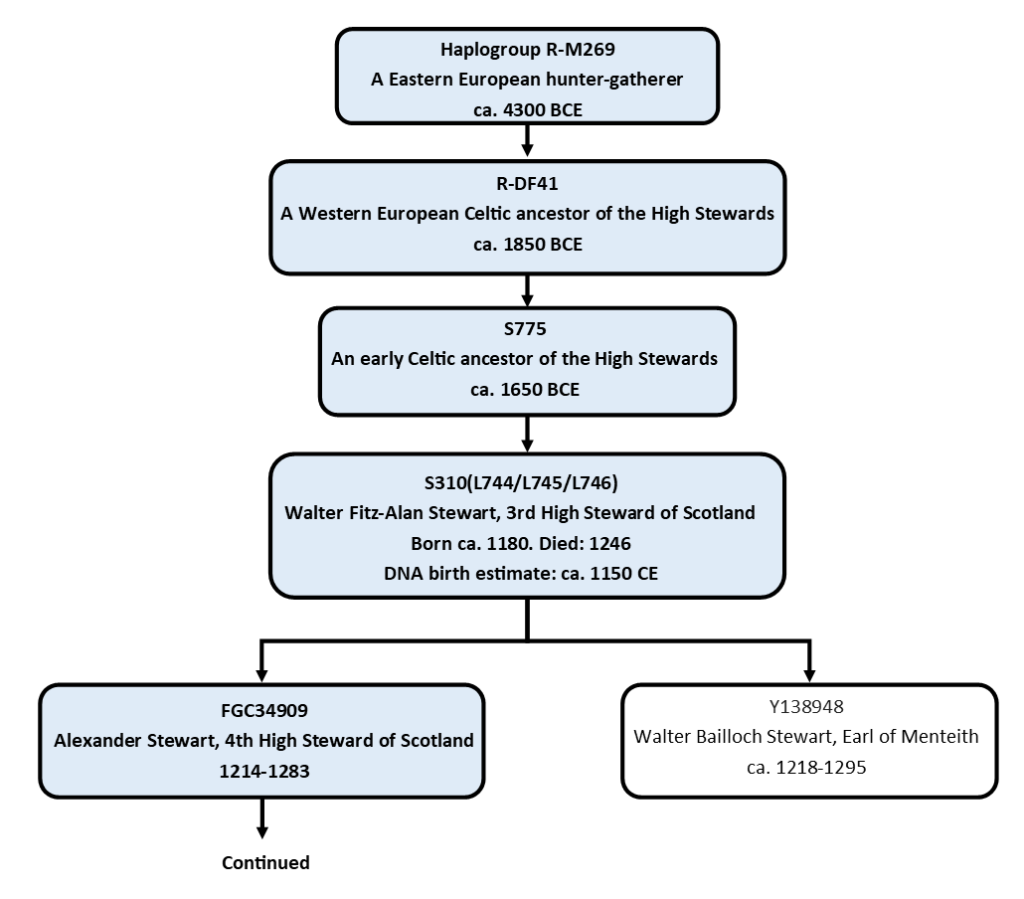
You can see that we do not gain any degree of precision until we get to Walter Fitz-Alan, 3rd High Steward of Scotland, who lived in the 12th and 13th centuries. He was the first to adopt the surname Stewart.
If your Y-DNA result shows positive for SNP S775, but negative for SNP S310 (also known as L744, L745 or L746), then all that is known about your male ancestral line is that it connects with the male ancestors of Walter Fitz-Alan sometime prior to his birth and as far back as an unknown Celt who lived around 1650 BCE.
Descendants of Walter Fitz-Alan, 3rd High Steward of Scotland (S310, L744, L745 or L746)
If your Y-DNA result shows positive for SNP S310, L744, L745 or L746 then you know that you descend from Walter Fitz-Alan, 3rd High Steward of Scotland. The SNPs of S310, L744, L745 and L746 are essentially four different labels for the same SNP.*
* Why does this subclade have four different names?
Different genetic testing centres use different naming conventions. For our discussion, you can consider that SNP S310, L744, L745 and L746 all mean the same thing.
Walter Fitz-Alan Stewart, 3rd High Steward of Scotland had ten children – five daughters and five sons:
- William Stewart, b. UNKNOWN, Scotland , d. UNKNOWN
- Isabella (Sybella) Stewart, b. UNKNOWN, Scotland , d. UNKNOWN
- Euphemia Stewart, b. Abt 1206, Scotland , d. 1267, Whittingham, East Lothian, Scotland (Age ~ 61 years)
- Margaret Stewart, b. Abt 1206, Scotland , d. Abt 1234, Scotland (Age ~ 28 years)
- Beatrix (Elizabeth) Stewart, b. Abt 1208, Scotland , d. Bef 12 Mar 1251, probably Scotland (Age ~ 43 years)
- Daughter Stewart, b. Abt 1210, Scotland , d. UNKNOWN
- Alexander Stewart, 4th High Steward of Scotland, b. 1214, Crawford, Lanarkshire, Scotland , d. 1283, probably Scotland (Age 69 years)
- John Stewart, b. Abt 1216, Scotland , d. 1249, Damietta, Egypt (Age ~ 33 years)
- Walter Bailloch Stewart, Earl of Menteith, b. Abt 1218, Scotland , d. 1295 (Age ~ 77 years)
- Sir Robert Stewart, of Tarbolten, b. Abt 1223, Tarbolton, Ayrshire, Scotland , d. UNKNOWN
Y-DNA can only identify male lines. It cannot identify the descendants of Walter’s daughters. Of his five sons, only Alexander Stewart, the 4th High Steward, and Walter Bailloch Stewart, Earl of Menteith, are known to have had male descendant lines who continue to the present day. Each of their lines have been tested and SNP markers have been identified for them.
If your Y-DNA profile shows positive for SNP S310, L744, L745 or L746, then you know you descend from Walter Fitz-Alan through one of those two sons. If you descend from Alexander Stewart, 4th High Steward, then you will carry the additional SNP of FGC34909. If you descend from Walter Bailloch Stewart, Earl of Menteith, then you will carry the additional SNP of Y138948.
We know that the Stewarts of Balquhidder descend from Alexander Stewart, 4th High Steward of Scotland, so we will continue to follow the genetic line of FGC34909
Degrees of Y-Testing (Y-37, Y-111, Y-700)
Y-DNA tests come in three degrees of precision: Y-37 (least precise), Y-111 (mid-precision), and Y-700 (most precise). The cost of the test is, of course, proportional to it’s degree of precision. The Y-700 test is quite expensive. Please consult the Family Tree DNA website for prices in your country.
The Y-37 test is only precise enough to identify your genetic ancestry to around the level of the R-M269 haplogroup (or equivalent).*
The Y-111 test may be able to identify your genetic ancestry to around the level of R-L745 (or equivalent).*
You might be eligible for an SNiP Pack test which can test for specific SNiPs without doing the full Y-700 test to verify or eliminate a specific branch possibility.
But, to determine where you fit in the genetic tree more recently than Walter Stewart, 3rd High Steward, would usually require a Y-700 test.
* These statements are not guarantees of what your Y-DNA results will reveal. They are examples based on the results of other testers. Every test is unique.
Descendants of Alexander Stewart, 4th High Steward of Scotland (FGC34909)
Descendants of Alexander Stewart, 4th High Steward of Scotland carry the additional SNP of FGC34909. Alexander had six children – three sons and three daughters. Y-DNA can’t identify his daughters’ descendants. Only two of his sons have living descendants. So we see two different genetic lines descending from Alexander Stewart. Namely, his eldest surviving son, James Stewart, 5th High Steward of Scotland and his younger son, Sir John Stewart of Bonkyll.
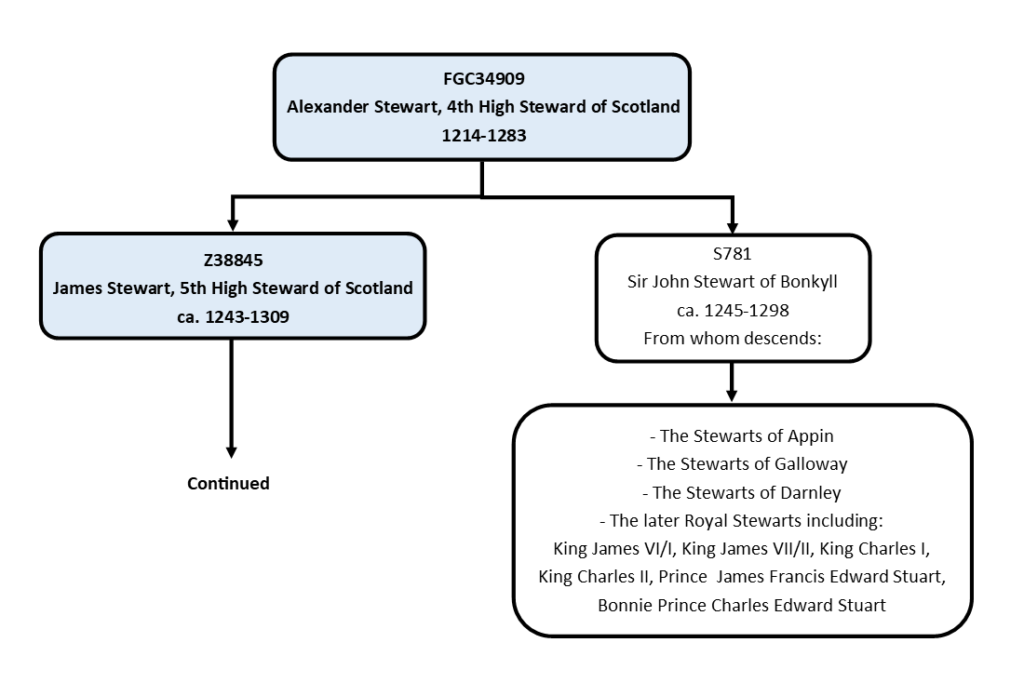
Enough descendants of Alexander Stewart have been tested that it is possible to identify the unique SNP for each of his two surviving genetic lines. Descendants of James Stewart, 5th High Steward of Scotland, carry the SNP of Z38845. This includes the Royal Stewarts and the Stewarts of Balquhidder among a multitude of other families. Descendants of his younger son, Sir John Stewart of Bonkyll carry the SNP of S781. This includes such families as the Stewarts of Appin, Stewarts of Galloway, Stewarts of Darnley, and the later Royal Stewarts after King James V died with no male heirs and the crown passed to his daughter, Mary, Queen of Scots. While King James V had no surviving legitimate male heirs, he had a lot of illegitimate sons, many of whom have surviving male descendants today. DNA doesn’t care if children are legitimate or not. Illegitimate sons still carry their father’s Y-DNA. Thus, even though King James V had no legitimate male heirs, it is still possible to identify his genetic signature through the descendants of his illegitimate sons.
As the Stewarts of Balquhidder descend from James Stewart, 5th High Steward of Scotland, we shall continue to follow that line.
Descendants of James Stewart, 5th High Steward of Scotland (Z38845)
Descendants of James Stewart, 5th High Steward of Scotland carry the additional SNP of Z38845. James only had one surviving son, Walter Stewart, 6th High Steward of Scotland. Thus, descendants of Walter Stewart, 6th High Steward, would carry the same SNP of Z38845. So it is impossible to genetically distinguish between James Stewart, 5th High Steward, and his son Walter Stewart, 6th High Steward. From the point of view of Y-DNA, they are identical.
Descendants of Walter Stewart, 6th High Steward of Scotland (Z38845)
Walter Stewart, 6th High Steward, had the following children:
- Robert Stewart, 7th High Steward of Scotland and latterly King Robert II of Scots, b. 2 Mar 1316, Paisley, Renfrewshire, Scotland , d. 14 Apr 1390, Castle Dundonald, Ayrshire, Scotland (Age 74 years)
- Sir John Stewart, of Ralston, b. 1318, Scotland , d. 1416, Scotland (Age 98 years)
- Sir Andrew Stewart, b. Abt 1320, Scotland , d. Bef 1413 (Age ~ 92 years)
- Egedia Stewart, b. Abt 1322, Scotland , d. UNKNOWN
- Jean Stewart, b. Abt 1325, Scotland , d. UNKNOWN
Walter’s eldest son, Robert, became King Robert II of Scots. We shall deal with his descendants below.
Walter’s next son, Sir John Stewart of Ralston had male heirs but his male line died out after two generations, thus there is no surviving genetic marker for his line.
Walter’s third son, Sir Andrew Stewart, had no known male heirs. His line also died out.
Thus, only the line of King Robert II survives, so the SNP marker of Z38845 continues through him and he cannot be genetically distinguished from his father or his grandfather.
Descendants of King Robert II – The Royal Stewart Marker (Z38845)
Since King Robert II is the only male descendant of James Stewart, 5th High Steward of Scotland, through whom Y-DNA can be traced, then all of King Robert II’s male descendants will carry the SNP of Z38845.
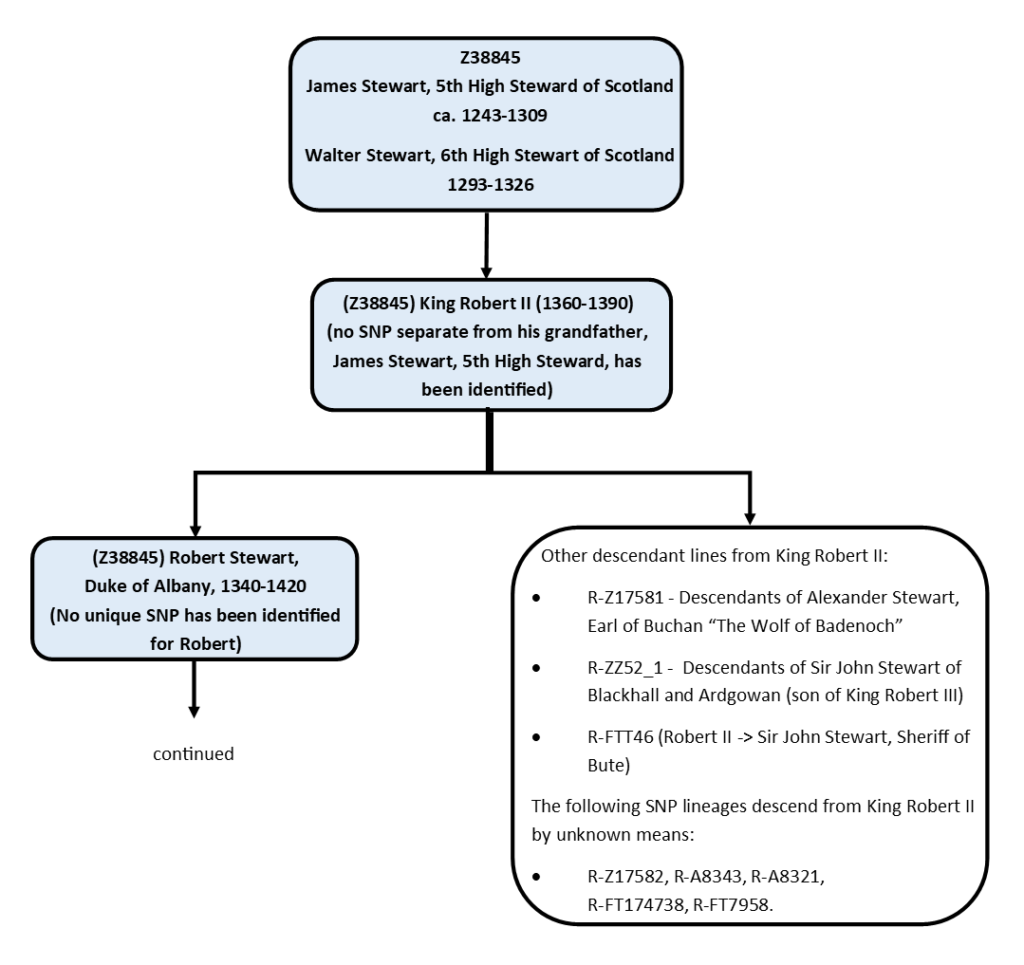
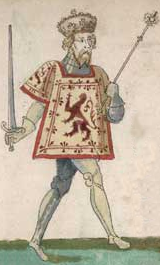
King Robert II had more than 24 children, including:
- 6 legitimate sons
- 9 illegitimate sons
- 8 legitimate daughters
- an unknown number of illegitimate daughters
Remember, Y-DNA can’t see daughters and does not care about legitimacy. King Robert II had 14 sons, most of whom had prolific families with descendants who survive to this day. King Robert II is the ancestor of at least 10 distinct descendant male genetic lineages, including:
- R-Z17581 – which has been identified as descendants of his son, Alexander Stewart, Earl of Buchan, known as “The Wolf of Badenoch.”
- R-ZZ52_1 – which has been identified as descendants of his grandson, Sir John Stewart of Blackhall and Ardgowan, through King Robert II’s son, King Robert III.
- R-FTT46 – which has been identified as descendants of his illegitimate son, Sir John Stewart, Sheriff of Bute.
- R-BY184394 and R-Y60195 – which have been identified as descendants of his son, Robert Stewart, Duke of Albany. These lines are discussed more fully below.
And the following whose ancestry is unknown:
- R-Z17582, R-A8343, R-A8321, R-FT174738, R-FT7958
These unknown SNP lines are a perfect illustration of why “your mileage may vary” when it comes to Y-DNA test results. Either not enough people have tested in these groups or not enough is known about their ancestry to determine how they descend from King Robert II. This is likely because the documentation simply doesn’t exist for these present-day testers to trace their ancestry back far enough to connect with King Robert II.
The Dukes of Albany (R-BY184394 & R-Y60195)
The Stewarts of Balquhidder line follows from King Robert II through his third lawful son, Robert Stewart, Duke of Albany.
Robert Stewart, Duke of Albany, had twelve children including four sons. Of those four sons, only his eldest son, Murdoch Stewart, 2nd Duke of Albany, had male descendants, and several of those were executed by King James I. Only two lines survived, namely, the descendants of his sons Sir Walter Stewart of Fife (including the Stewarts of Morphie and the later Lords Avendale and Ochiltree), and Sir James Mhor Stewart of Albany (ancestor of the Stewarts of Balquhidder).
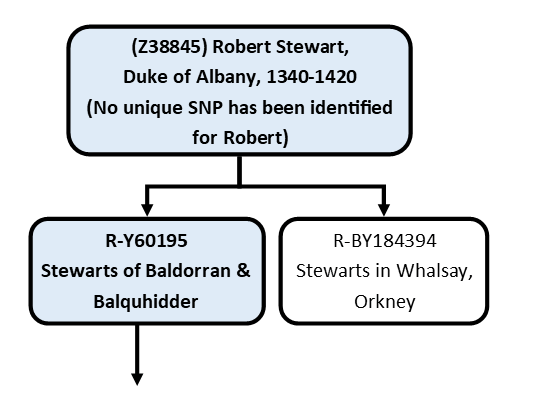
Sir Walter Stewart of Fife was executed by King James I, but his children survived. Sir James Mhor Stewart of Albany escaped the King’s wrath by fleeing to Ireland with the children of his executed brother, Walter. While in Ireland, Sir James had a son, James Beag Stewart, latterly of Baldorran and Balquhidder, who was eventually permitted to return to Scotland where he founded the Stewarts of Balquhidder.
Genetically, there are two known lines that survive from Robert Stewart, Duke of Albany, both likely coming through his son, Murdoch. They are:
- R-BY184394 – who represent a family of Stewarts in Whalsay, Orkney. This family descends by unknown means from Robert Stewart, Duke of Albany. They most likely descend from an unknown line of the Stewarts of Morphie, Avendale, or Ochiltree, but there are, as yet, insufficient testers from this line or insufficient information to identify their precise origin.
- R-Y60195 – who represent the descendants of James Beag Stewart, 1st of Baldorran, and progenitor of the Stewarts of Balquhidder.
The Stewarts of Baldorran and Balquhidder (R-Y60195)
James Beag Stewart, 1st of Baldorran and Balquhidder, was the progenitor of the Stewarts of Balquhidder. The Stewarts of Balquhidder comprise four primary descendant houses:
- The Stewarts of Ardvorlich (the senior line)
- The Stewarts of Glenbuckie
- The Stewarts of Gartnafuaran
- The Stewarts of Annat
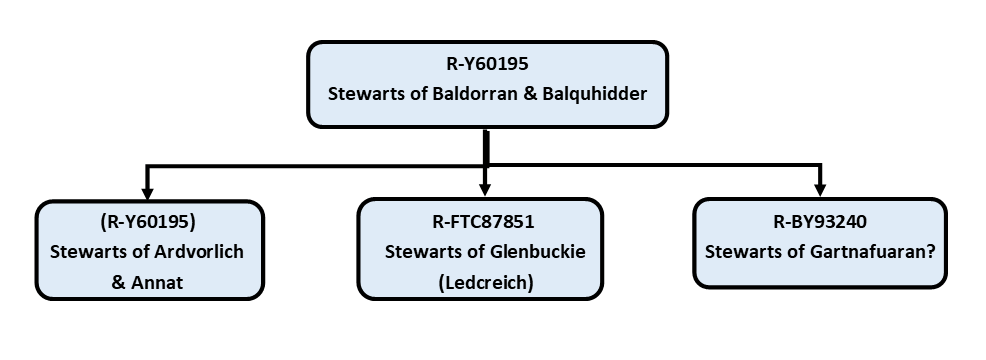
The main line of the Stewarts of Baldorran and Balquhidder, which includes the later senior line of the Stewarts of Ardvorlich and the junior line of the Stewarts of Annat is represented by the SNP of R-Y60195.
We have had a small group of testers who are known to descend from the later Stewarts of Ledcreich (a cadet branch of the Stewarts of Glenbuckie) who carry the SNP of R-FTC87851. By a strange quirk of early family politics where two early brothers of the Stewarts of Glenbuckie exchanged their hereditary rights, the Stewarts of Ledcreich while being a lesser cadet branch of the Stewarts of Glenbuckie, are actually the senior genetic line of that principal family.
We have a pair of testers who carry the SNP of R-BY93240 whom we suspect descend from the Stewarts of Gartnafuaran, but more research is required to confirm their connection.
More Testers and More Research Needed
It is in these later results where we can see the need and value for further Stewart-surnamed men to come forward to be tested at the Y-700 level. The more results we have, the more accurate we’re able to identify each branch and break them down into their constituent sub-branches.
On one hand, for the Stewarts of Balquhidder, we’re close to confidently identifying the SNPs for the four major houses as recently as the 16th century.
On the other hand, we noted above where there are 5 SNPs descending from James Stewart, 5th High Steward of Scotland, who cannot identify their origins any more precisely than the 12th century, either due to insufficient testers, or insufficient knowledge of their ancestral lines.


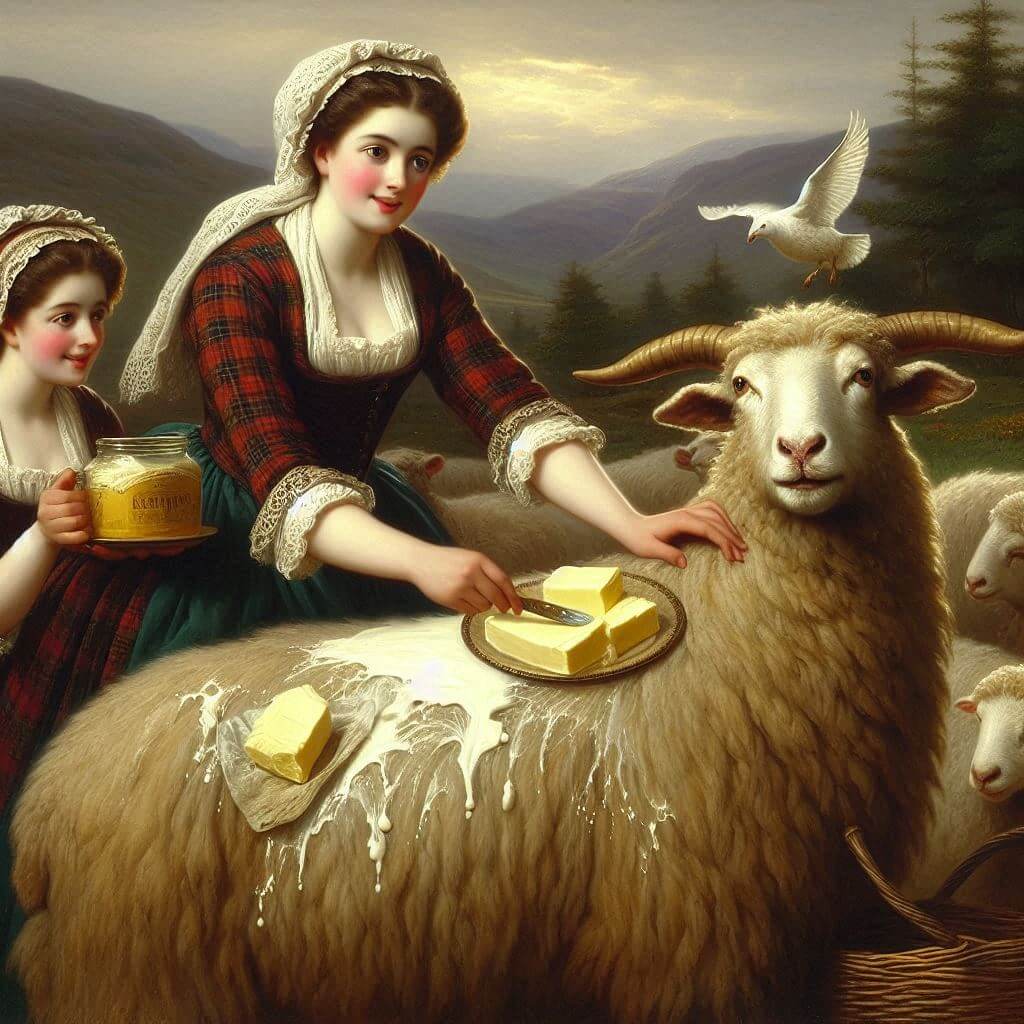
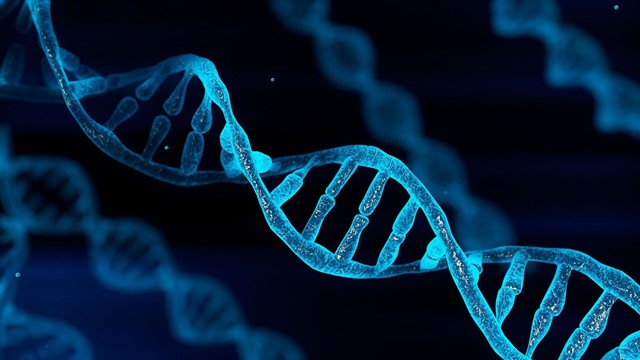

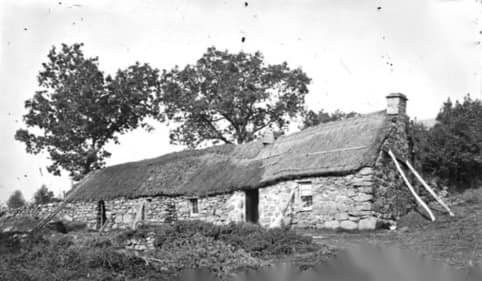
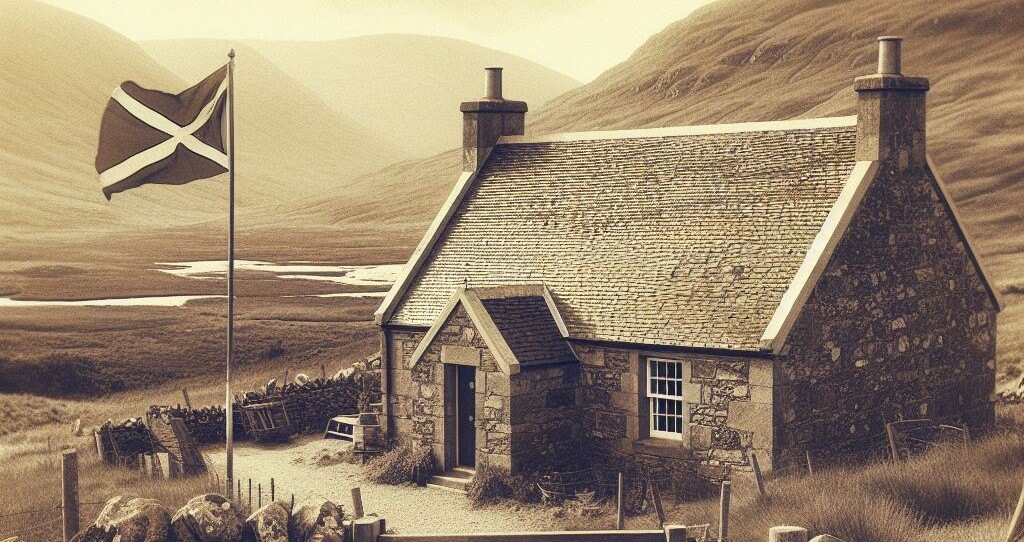
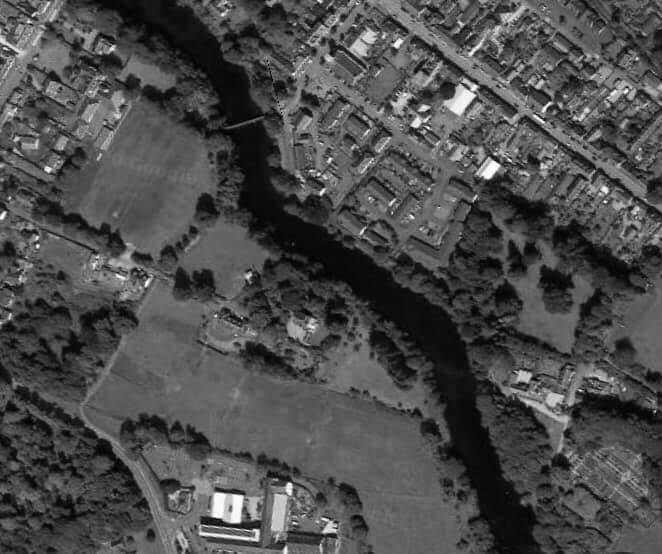
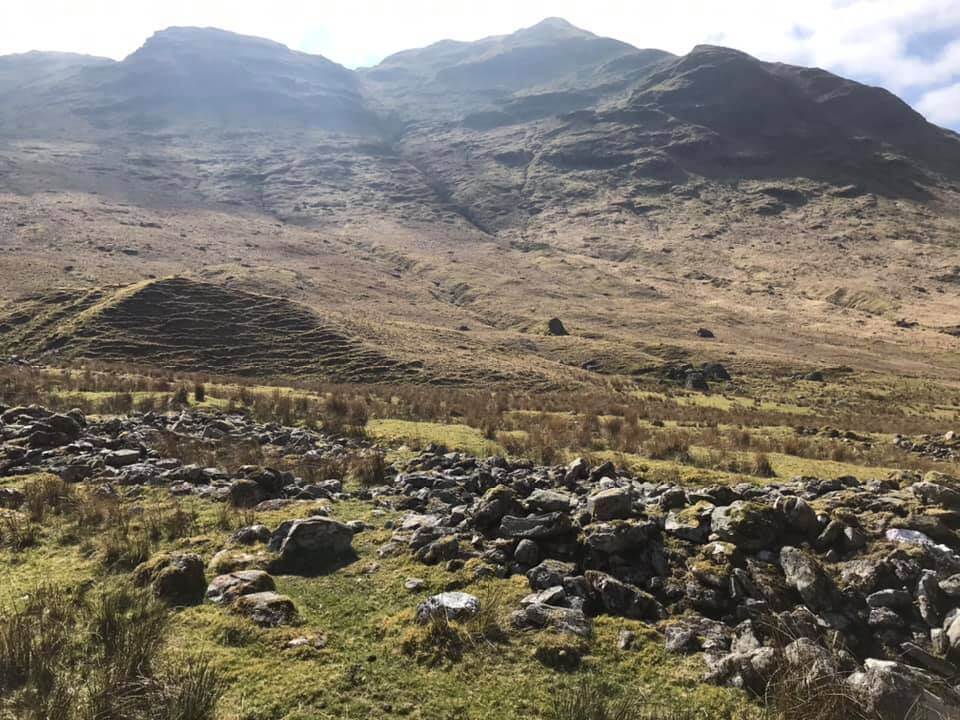
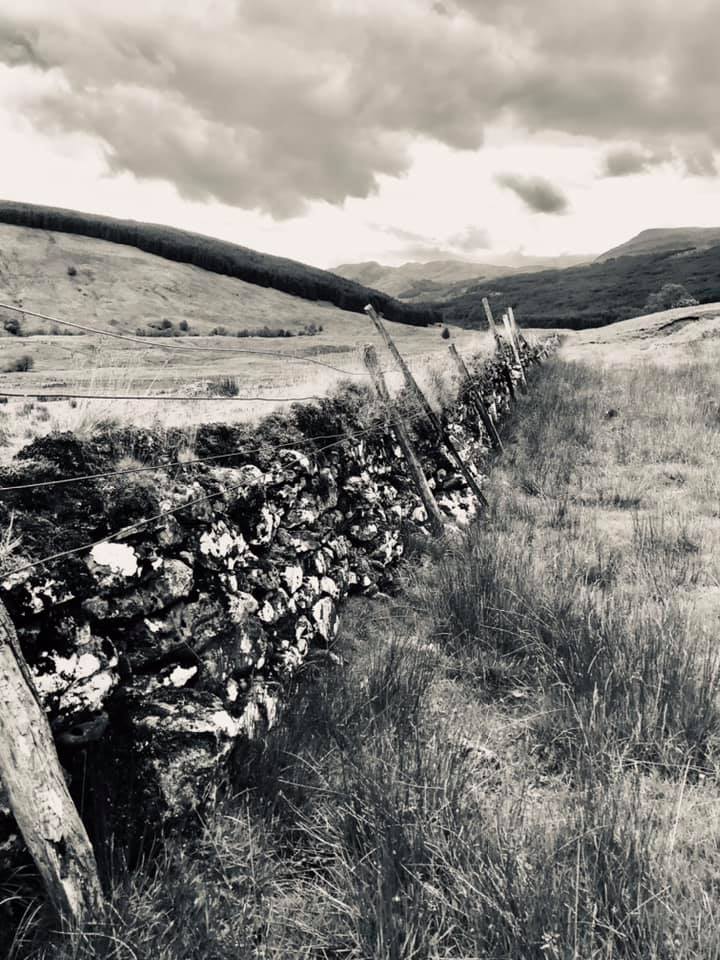
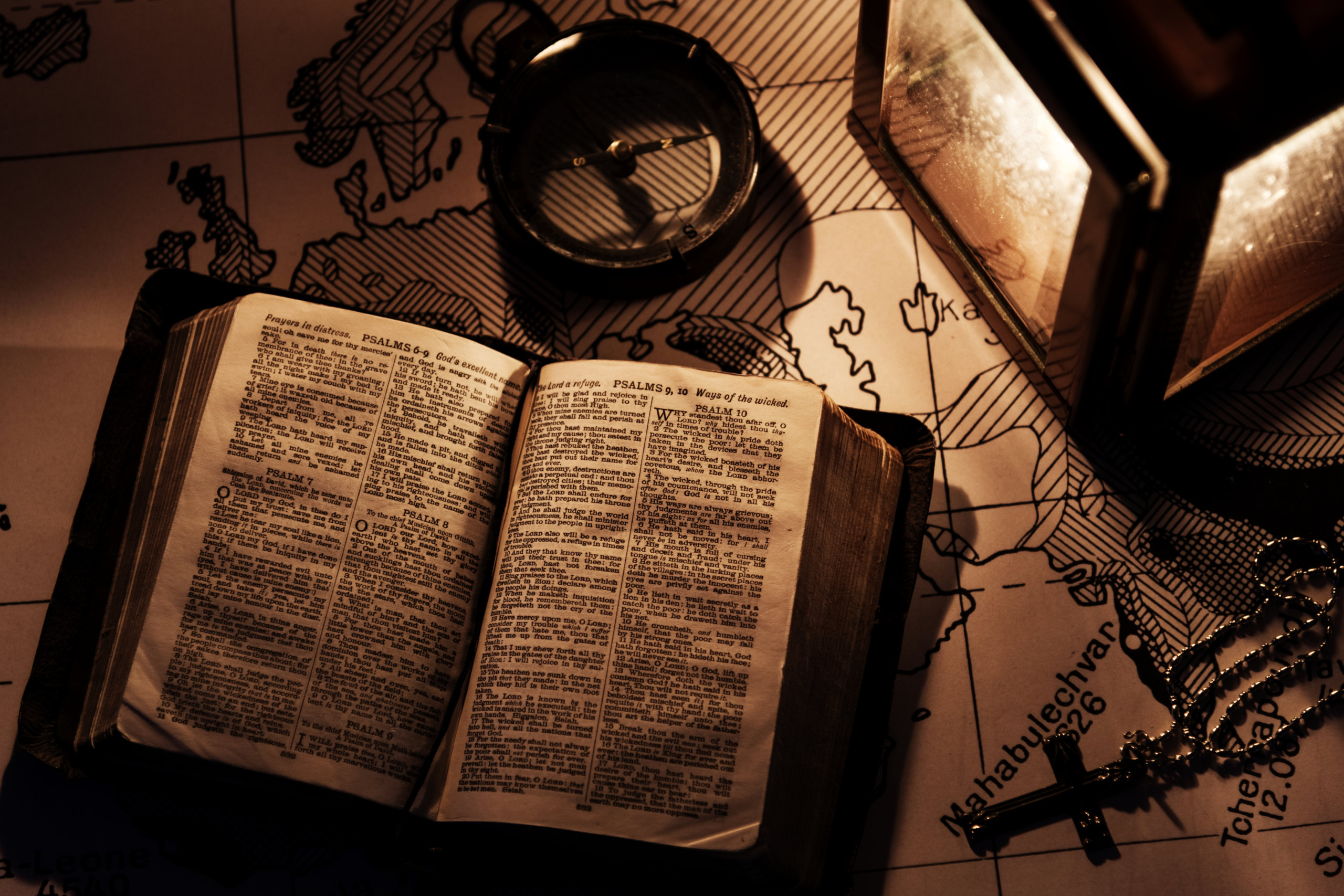
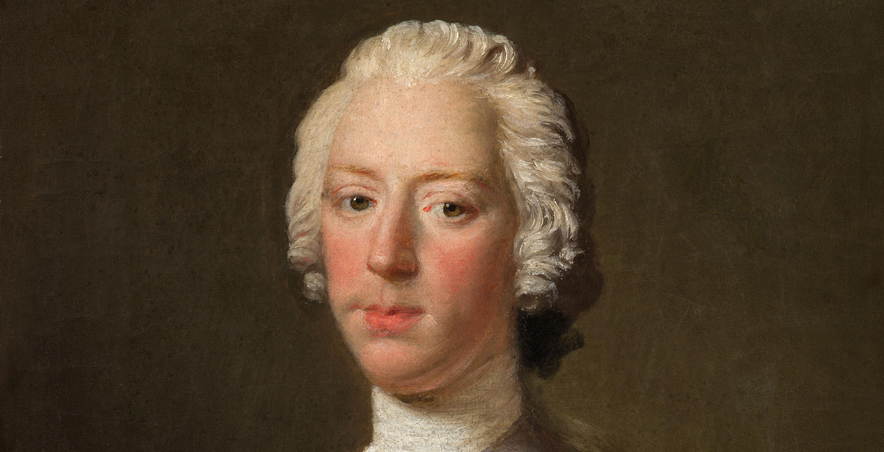
0 Comments